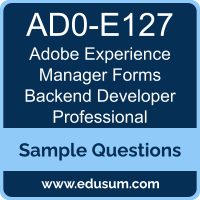01. Under which folder path in CRXDE Lite can an AEM Forms developer find the default toolbar actions that are supported by Adaptive Forms?
a) /libs/fd/af/components/toolbar/actions
b) /conf/fd/af/components/toolbar/actions
c) /libs/fd/af/components/actions
d) /apps/fd/af/components/toolbar/actions
02. A developer is required to schedule and manage multiple asynchronous batch processes using the Watchfolder endpoint. The processes involve handling various types of documents, such as PDFs, images, and Word documents, and require different processing workflows.
Which three steps should the developer take to achieve this goal, leveraging the Watchfolder endpoint in AEM Forms?
(Choose three.)
a) Create custom OSGi services to handle different document types and processing workflows.
b) Configure the Watchfolder endpoint with the input folder locations for each batch process.
c) Utilize the AEM Forms Workbench to design and deploy the batch process workflows.
d) Configure Dynamic media to handle different document types and batch processing
e) Create Asset profiles to trigger the processing workflows.
f) Monitor the Watchfolder to detect incoming documents and trigger the appropriate processing workflows.
03. You recently took over the role of an AEM Forms backend developer for a government agency. As part of your administration responsibilities, you need to ensure that the AEM Forms environment is secure and compliant with industry standards.
What activity should you prioritize to achieve this goal?
a) Enable adaptive forms for responsive user experiences.
b) Create custom templates for form design.
c) Configure data sources for form integration.
d) Set up SSL certificates for secure communication.
04. An AEM Forms developer is working on tables in adaptive forms and wants to configure a mobile layout for a table. What are the two types of layouts offered by AEM Forms?
(Choose two.)
a) Headers on left
b) Collapsible rows
c) Collapsible columns
d) Headers on right
05. In XFA/XDP design, various outputs can be generated to cater to different needs and platforms. Which statement accurately identifies and explains one of these outputs?
a) PDF Output: Provides a printable and static representation of the form, preserving the layout and design.
b) XML Data Output: Exports form data in XML format, facilitating data interchange with external systems.
c) HTML Output: Enables responsive web forms for easy accessibility and data collection through web browsers.
d) Mobile Output: Optimizes the form design and layout for mobile devices, ensuring a user-friendly experience.
06. What is the first step to identify the steps for implementing a Form approval workflow in a given scenario?
a) Analyze the form approval requirements and identify stakeholders.
b) Implement the workflow using a workflow management tool.
c) Integrate the workflow with the company's user authentication system.
d) Design the approval workflow stages and participants.
07. In the context of a Form approval workflow, what is the initial step that typically takes place when a form submission is received?
a) Sending an email confirmation to the form submitter.
b) Archiving the form submission for future reference.
c) Automatically approving the form without any human intervention.
d) Triggering a notification to the designated approver.
08. Which two steps are required to generate platform endpoints?
(Choose two.)
a) x-wt-ims-org-id: {IMS_ORG}
b) Authorization: Bearer {ACCESS_TOKEN}
c) x-sandbox-name: {SANDBOX_NAME}
d) x-api-key: {API_KEY}
09. On which UI element can an AEM Forms developer find the Emulator button?
a) Sidebar
b) Component toolbar
c) Page toolbar
d) Main toolbar
10. Which issues can be commonly generated in log files of an application?
(Choose two.)
a) Warnings for performance degradation due to network or client-side Issues
b) Error messages related to application crashes or exceptions.
c) Debugging information for tracing the flow of execution and variable values.
d) Info messages of browser-specific issues that affect user experience.
 The purpose of this Sample Question Set is to provide you with information about the Adobe Experience Manager Forms Backend Developer Professional exam. These sample questions will make you very familiar with both the type and the difficulty level of the questions on the AD0-E127 certification test. To get familiar with real exam environment, we suggest you try our Sample Adobe Experience Manager Forms Backend Developer Professional Certification Practice Exam. This sample practice exam gives you the feeling of reality and is a clue to the questions asked in the actual Adobe Experience Manager Forms Backend Developer Professional certification exam.
The purpose of this Sample Question Set is to provide you with information about the Adobe Experience Manager Forms Backend Developer Professional exam. These sample questions will make you very familiar with both the type and the difficulty level of the questions on the AD0-E127 certification test. To get familiar with real exam environment, we suggest you try our Sample Adobe Experience Manager Forms Backend Developer Professional Certification Practice Exam. This sample practice exam gives you the feeling of reality and is a clue to the questions asked in the actual Adobe Experience Manager Forms Backend Developer Professional certification exam.